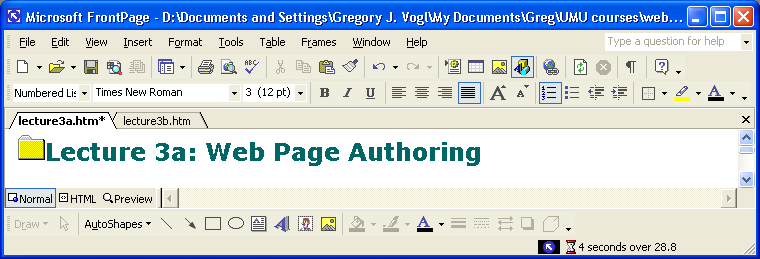 Lecture 3a: Web
Page Authoring
Lecture 3a: Web
Page Authoring
What You Will Learn Today
- Explain the web development process.
- Explain the uses of different types of web authoring tools.
- Identify structural and functional features of web pages.
- Explain common features of web page authoring and web
site management tools.
- define site purpose and audience
- select development tools and processes
- design the site
- develop the site
- test the site
- publish the site
- evaluate, update and maintain the site
In which step are web pages actually created? Are the steps followed in
order?
- Text editors edit the HTML source codes giving advanced designers
maximum control.
- Word processors can be used to create web pages by exporting
(saving) in HTML format.
- HTML editors have features to help with editing HTML.
- WYSIWYG editors edit the page as it will look when published on the
Web.
- Graphical tools create formatted text, images, animations and
backgrounds.
- Scripting and programming languages and server tools provide programming,
interactivity and advanced features.
- Properties (title, author, keywords, description, colours,
background, language, modification date)
- Formatting (font style, font size, bold, italic, underline, font
colour, background colour, highlight colour, stylesheets)
- Layout including Alignment (left, centered, right, justified) and Indentation
(block quote)
- Structural Elements (Headings, Paragraphs, Line Breaks, Horizontal Lines)
- Lists (bulleted, numbered, definition)
- Links (relative vs. absolute; text vs. picture; named anchors)
- Tables (with captions, merged cells etc.)
- Images (including diagrams, photos, image maps, animated gifs,
Shockwave)
- Forms (buttons, text boxes and menus within a web page)
- Frames (independent windows within a web page)
- Plug-Ins (multimedia files viewed by programs that add to the
browser's capabilities)
Features of Web Page Authoring Tools
- Web page authoring tools like Mozilla Composer focus only on
designing individual pages:
- Standard word processing features including file management,
editing, formatting and page layout
- Buttons and menus to add web page features listed above
- Ability to switch between viewing modes (e.g. Normal, HTML tags, HTML source,
and Preview)
- Web site management tools like Microsoft FrontPage and Macromedia
Dreamweaver facilitate maintaining an entire site of many pages:
- Site structure management tools (files, folders, links/navigation)
- Site analysis tools (reports, statistics, problems)
- Task management tools (to do list, scheduling)
- Publishing tools (to update the uploaded site)
To Do After Class
- Read Hofstetter ch. 15, 16 and 18.
- Read
Computers
in Your Future module 8b:
creating a
web page, first half.
- View the lists of web authoring software for
Windows and
Linux.
- View the
web authoring and HTML links.
- Become familiar
with available
web editors such as Mozilla Composer and Microsoft FrontPage.
- Find out how you use the features listed above.

